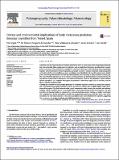Por favor, use este identificador para citar o enlazar a este item:
http://hdl.handle.net/10261/147145COMPARTIR / EXPORTAR:
 SHARE SHARE
 CORE
BASE CORE
BASE
|
|
| Visualizar otros formatos: MARC | Dublin Core | RDF | ORE | MODS | METS | DIDL | DATACITE | |

| Título: | Dietary and environmental implications of Early Cretaceous predatory dinosaur coprolites from Teruel, Spain |
Autor: | Vajda, Vivi; Pesquero, María Dolores CSIC ORCID; Villanueva-Amadoz, Uxue; Lehsten, Veiko; Alcalá, Luis | Palabras clave: | Coprolite Teruel Palynology Charcoal Wild fires Cretaceous |
Fecha de publicación: | 15-dic-2016 | Editor: | Elsevier | Citación: | Palaeogeography, Palaeoclimatology, Palaeoecology 464: 134-142 (2016) | Resumen: | Coprolites from the Early Cretaceous vertebrate bone-bed at Ariño in Teruel, Spain, were analyzed geochemically and palynologically. They contain various inclusions, such as small bone fragments, abundant plant remains, pollen, and spores. We attribute the coprolites to carnivorous dinosaurs based partly on their morphology together with the presence of bone fragments, and a high content of calcium phosphate (hydroxylapatite) with calcite. Well-preserved pollen and spore assemblages were identified in all coprolite samples and a slightly poorer assemblage was obtained from the adjacent sediments, both indicating an Early Cretaceous (Albian) age. This shows that the coprolites are in situ and also confirms previous age determinations for the host strata. The depositional environment is interpreted as a continental wetland based on the palynoflora, which includes several hydrophilic taxa, together with sparse occurrences of fresh-water algae, such as Ovoidites, and the absence of marine palynomorphs. Although the coprolites of Ariño samples generally are dominated by pollen produced by Taxodiaceae (cypress) and Cheirolepidiaceae (a family of extinct conifers), the sediment samples have a slightly higher relative abundance of fern spores. The distribution of major organic components varies between the coprolite and sediment samples, which is manifest by the considerably higher charcoal percentage within the coprolites. The high quantities of charcoal might be explained by a ground-dwelling species, feeding on smaller vertebrates that complemented its diet with plant material from a paleoenvironment were wild fires were a part of the ecosystem. The state of preservation of the spores and pollen is also more detailed in the coprolites, suggesting that encasement in calcium phosphate may inhibit degradation of sporopollenin. | URI: | http://hdl.handle.net/10261/147145 | DOI: | 10.1016/j.palaeo.2016.02.036 | Identificadores: | doi: 10.1016/j.palaeo.2016.02.036 issn: 0031-0182 |
| Aparece en las colecciones: | (MNCN) Artículos |
Ficheros en este ítem:
| Fichero | Descripción | Tamaño | Formato | |
|---|---|---|---|---|
| palaeo3-464_134–142(2016).pdf | 1,54 MB | Adobe PDF |  Visualizar/Abrir |
CORE Recommender
SCOPUSTM
Citations
26
checked on 03-abr-2024
WEB OF SCIENCETM
Citations
24
checked on 23-feb-2024
Page view(s)
282
checked on 22-abr-2024
Download(s)
248
checked on 22-abr-2024
Google ScholarTM
Check
Altmetric
Altmetric
Este item está licenciado bajo una Licencia Creative Commons

